#SEO case study
Text
Read This Full Helpful Content Guide for 2024
Content secrets revealed! Unlock expert tips for creating helpful content that wins in 2024. Read full blog to create helpful content.
#Helpful Content#Top SEO Freelancer in India#seo case study#seo freelancer for small businesses in india#seo freelancer for e-commerce websites in india#seo#seo services#seo marketing#seo freelancer for startups in india#digital pool seo freelancer#seo freelancer
0 notes
Text
#SEO Case Study#Case Study#Google’s 3-Pack#Google’s 3-Pack kayword#First Page#First Page ranking#top business directory in malaysia#business listing#business directory in malaysia#digital marketing#marketing#business growth#small business#local small business
0 notes
Text
SEO Case Study for (Long Law Firm)
Aamir Digital Media undertook an SEO campaign aimed at enhancing online visibility and organic search rankings for a client specializing in legal services, law firms, and lawyers. The client sought to establish a strong online presence within their niche, attract more qualified leads, and ultimately increase client acquisition through their website. This case study outlines the strategies…
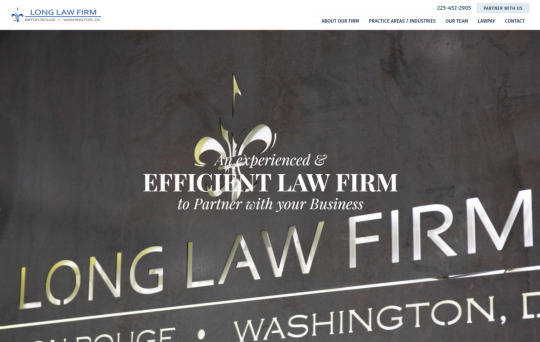
View On WordPress
0 notes
Text
SEO CASE STUDY: STRATEGY TO OVERCOME SEASONALITY, PPC COMPETITION AND NICHE CRISIS FOR LOCAL ECOMMERCE BUSINESS

In this SEO case study, we will be discussing a strategy to promote a local e-commerce business in Canada that is facing three major challenges: seasonality, intense PPC competition, and a niche crisis due to a decrease in search volume. We will be sharing a step-by-step approach to overcome these challenges and drive traffic to the website through SEO tactics. This article will provide valuable insights for e-commerce businesses struggling with similar issues and looking for innovative solutions to boost their online presence.
ABOUT DECK TORONTO SEO CASE CHALLENGE
The Decks Toronto project is an online ecommerce store based in Canada, operating on the Laravel framework. The business focuses on delivering goods across the Greater Toronto Area (GTA), but also offers delivery outside of the area. The client was looking to increase their visibility in cities such as Toronto, Ontario, Markham, and Barry.
One of the strengths of the project is its domain name – Deck Toronto, which allows it to rank well for geo-targeted searches containing “toronto.” Additionally, the site has an advantage due to its age and reputation, which makes it easier to rank new pages in the top 30 results for low or medium frequency queries. The site also had good behavioral factors with an average time of 1.5 minutes and 2 page views per session.
However, the site does have weaknesses, particularly in the lack of a full-fledged product catalog with filters, making it difficult to promote brand collections and product pages effectively.
UNRAVELING THE TANGLE OF SEASONALITY, PPC COMPETITION AND NICHE CRISIS ISSUES
We faced a tangle of challenges that threatened our growth and profitability. The first issue was the general crisis affecting our niche, which had led to a steady decline in demand for our goods. At the same time, traffic was strongly affected by seasonality, when demand for a product is very low for half a year. Additionally, we faced fierce competition from other vendors and numerous PPC ads that often diverted traffic away from our site.
Our main goal was to develop a comprehensive strategy that could help us overcome these challenges and achieve sustainable growth. Our strategy was not solely focused on improving traffic but rather, we aimed to achieve three key objectives. First, we wanted to surpass last year’s traffic levels. Secondly, we wanted to increase our visibility for brand-specific transactional keywords and boost existing rankings. Finally, we aimed to reduce the impact of PPC ads on our transactional requests and ensure they don’t take away valuable traffic from our site.
With a well-thought-out strategy, we believe we have successfully navigated the challenges of seasonality, PPC competition, and niche crisis, and emerged stronger and more profitable.
STRATEGY FOR ECOMMERCE LOCAL BUSINESS SEO PROMOTION
A strong SEO promotion strategy is essential to successfully overcome the challenges of seasonality, PPC competition, and niche crisis for a local ecommerce business. The first step towards achieving this goal is conducting a thorough analysis of the niche and target audience. This analysis will enable us to identify the most effective keywords, content topics, and promotion channels. The focus should be on creating high-quality, engaging, and relevant content that meets the needs of the target audience while providing them with value. Social media platforms, email marketing, and influencer outreach are effective channels to promote our content and drive traffic to our website. Additionally, optimizing our website structure, metadata, and on-page content is essential to improve our search engine rankings and visibility in search results. By implementing these strategies, we can enhance our traffic, visibility, and keyword count year after year while minimizing the impact of PPC ads on our transactional requests.
Collecting data
To develop a highly effective SEO strategy, our team began the process by conducting a thorough data analysis from various sources. We used a combination of tools such as Google Analytics, Search Console, and Google Trends to gather valuable insights about the website’s performance, user behavior, and search trends. Additionally, we utilized more advanced research tools like SpySerp, Ahrefs, Serpstat, and Screaming Frog to gain crucial information on our competitors’ keywords, technical condition, backlinks, and website structure. This allowed us to have a comprehensive understanding of the market and identify areas for improvement. By pooling insights from these diverse sources, we were able to identify opportunities for improvement and devise a comprehensive plan to surmount the challenges of seasonality, PPC competition, and niche crisis for our ecommerce business client.
Basic technical optimization
As part of our comprehensive SEO strategy for Decks Toronto, we undertook basic technical optimization on the website to address critical issues affecting its performance. We identified and fixed problems such as 404 error pages and slow download speed, which impaired user experience. Moreover, we used best practices such as installing last-modified headers and adding structured data markup such as LocalBusiness, Breadcrumbs and Product schema. These technical improvements served as a solid starting point for further optimization efforts and helped boost the website’s overall search engine rankings and performance.
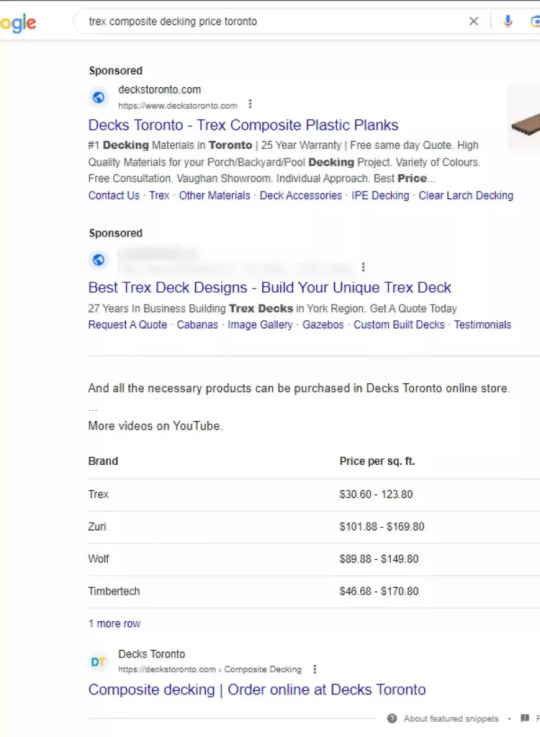
Winning PPC: add missed semantics for deck collections
Winning at PPC advertising was a crucial aspect of our SEO strategy. PPC cannot be overtaken in SERP, the presence of contextual advertising reduced the likelihood of users seeing our site in the search results, even if we ranked on the first page but in 7th-9th position. However, PPC ads tend to focus on short-tail keywords with high search volume, so we considered targeting long-tail keywords that are more specific to our local e-commerce business. So we decided to win a competition for long-tail keywords and get visibility on featured snippets. So, we used Ahrefs to identify long-tail keywords that have a higher chance of triggering a featured snippet and created high-quality content that provides clear and concise answers to common search queries. We made accents on adding tables and lists and using semantic tags to make our page structure understandable for Google bots. This approach helped us increase our visibility and drive traffic from low-volume keywords to the website, giving us a competitive advantage in the PPC landscape and attracting high-quality leads.

Overcoming seasonality: apply strong content marketing strategy for blog
To overcome the seasonal challenges faced by the deck-building industry, we implemented a robust content marketing strategy for the Decks Toronto blog. Following Google’s recommendation to create high-quality content, we focused on crafting comprehensive, engaging, and informative blog posts that provided valuable insights and addressed common industry questions. When compiling topics for the blog, we used Google Trends to select those that maintain high demand dynamics out of season. In addition to optimizing the blog, we also rewrote all the content on the catalog pages and gave an extended description for the product pages. By doing so, we succeeded in positioning the Decks Toronto as a trusted and authoritative source of information on deck-building, driving more traffic to the website. With a consistent and targeted content marketing approach, we were able to overcome seasonality challenges and establish Decks Toronto as a leading player in the industry.
Way out of a niche crisis: link building strategy
A link building strategy can be an effective way out of a niche crisis for a business.
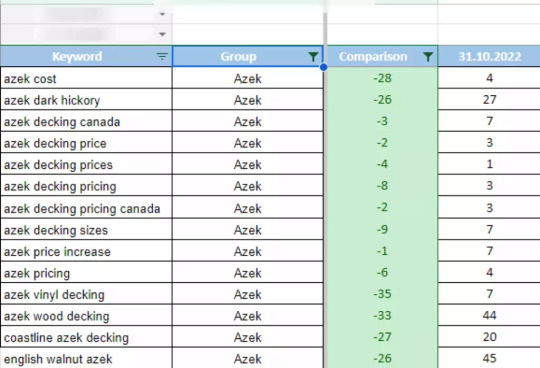
By acquiring high-quality backlinks from authoritative and relevant websites, a business can improve its search engine rankings and increase its visibility in the industry.
We’ve focused on building local backlinks that could help improve our local SEO by signaling to search engines that our site is relevant to the local area. We reached out to local bloggers, publications, and businesses to build backlinks to our local e-commerce site. We built a link profile not only for the main page, but also for brand catalog pages. Uniform distribution of link weight across the site, the ratio of anchor and non-anchor links of 20:80 and regularity allowed us to maintain a stable growth of traffic to catalog pages even with a small budget.
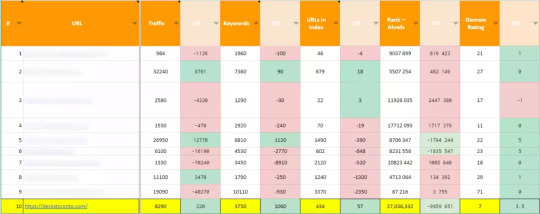
As a result, after six months, we were one of the few sites in the niche that survived the year without a drop in traffic and the number of keywords.
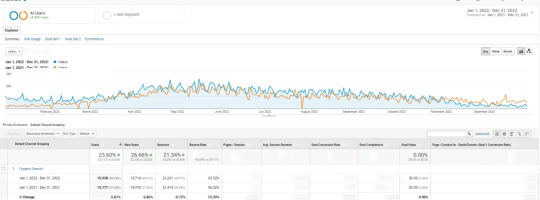
SUMMARY: WHAT TO DO FOR LOCAL SEO PROMOTION OF E-COMMERCE WEBSITES?
To overcome seasonal obstacles, competition in pay-per-click advertising, and niche crises, an ecommerce business like Decks Toronto must adopt a comprehensive SEO approach. This approach involves optimizing the website for relevant keywords and improving the user experience. It also requires leveraging PPC advertising to gain visibility, utilizing content marketing to establish the business as an industry authority and drive traffic to the website, and implementing a strong link-building strategy to improve search engine rankings and overcome niche crises. By combining these tactics and continuously monitoring and adjusting the strategy, the business can achieve sustainable growth and success.

GET A SEO AUDIT AND GROW YOUR VISIBILITY IN GOOGLE
Don’t let your website fall behind in Google’s search rankings! Book our comprehensive SEO audit today and get the insights you need to boost your visibility and drive more traffic to your site. The IM4U Digital Marketing Agency team of experts will analyze your website’s performance and provide customized recommendations to optimize your SEO strategy. Don’t miss out on potential customers – schedule your SEO audit now and take the first step towards dominating the search rankings!
#Local e-commerce business#Canada e-commerce#E-commerce challenges#Seasonality in e-commerce#PPC competition#Niche crisis#E-commerce SEO tactics#Boost online presence#E-commerce strategy#SEO case study#Local SEO promotion#Greater Toronto Area e-commerce#Toronto online store#E-commerce traffic generation#E-commerce visibility improvement#Target audience analysis#High-quality content marketing#Keyword optimization#Link building for SEO#E-commerce website performance
0 notes
Link
Expedia's case study highlights the importance of having an effective SEO strategy in place. It can help businesses improve their search engine ranking positions, drive traffic to their website, generate leads and sales, and ultimately increase revenue.
1 note
·
View note
Video
Unveiling SEO Excellence: 2xl Furniture Case Study by the Best SEO Company in Dubai. Witness the expert strategies employed by the leading SEO agency in UAE to boost online visibility, drive organic traffic, and achieve remarkable growth. Learn from industry pioneers and gain valuable insights for exceptional SEO services in Dubai, ensuring your business stands out in the digital landscape.
#seo case study#seo company in dubai#seo agency in dubai#seo services in dubai#seo solutions#dubai#uae#prismsocial
0 notes
Text
SEO Freelancer UK London England eCommerce Google Ranking Consultant Wordpress Shopify
https://www.seolady.co.uk/ Great British SEO Freelancer, eCommerce expert with 15+ years experience on UK website brands including Funky Pigeon, Rated People, Glastonbury Glamping and Henry Hoover.
ukseo #scotland #wales #england #shopifyseo #googleseo #ecommerceseo #freelanceseo #seoconsultant
Book a chat today direct on my website: https://www.seolady.co.uk/seo-quick-chat/
SEO LADY CASE STUDY - On Page SEO Content Before & After 30 Day SEO Booster
https://www.seolady.co.uk/on-page-seo-case-study-google/
WORDPRESS SEO CASE STUDY UK: Ecommerce and Revenue proof on Wordpress
https://www.seolady.co.uk/seo-case-study-2020-ecommerce-revenue-testimonial/
SHOPIFY SEO CASE STUDY UK: Ecommerce and Google ranking proof on Shopify
https://www.seolady.co.uk/shopify-ecommerce-seo-case-study/
somersetseo #localgoogle #westonsupermareseo #bristolseo #seoconsultant #soletrader #freelancinglife #wordpressseo #googleranking #seolessons #zoomconsultations
★ https://www.seolady.co.uk/SEO/freelance-seo-uk-case-study
★ https://www.seolady.co.uk/SEO/seo-training
★ https://www.seolady.co.uk/SEO/how-much-does-seo-cost
★ https://www.seolady.co.uk/SEO/seo-weston-super-mare
★ https://www.seolady.co.uk/SEO/search-engine-optimisation-consultant
★ https://www.seolady.co.uk/SEO/search-engine-optimisation
★ https://www.seolady.co.uk/SEO/organic-traffic
★ https://www.seolady.co.uk/SEO/local-website-marketing
★ https://www.seolady.co.uk/SEO/website-marketing
★ https://www.seolady.co.uk/SEO/search-engine-optimisation-bristol
★ https://www.seolady.co.uk/SEO/seo-bristol
★ https://www.seolady.co.uk/SEO/website-traffic
★ https://www.seolady.co.uk/SEO/search-engine-optimisation-freelancer
★ https://www.seolady.co.uk/SEO/all-seo-company-bristol
#seo case study#ecommerce seo case study#SEO Freelancer#SEO Consultant#SEO Consultant UK#SEO Freelance Consultant#British SEO Freelancer#Wordpress ecommerce seo UK#eCommerce shopify case study#seo lady#digital marketing#search engine optimisation UK#video seo#SEO Freelancer Costs#seo
0 notes
Link
Learn how a multilocation family-owned business used Leverable's #SEO strategy to boost organic visits by 1,415.63% and establish a strong regional online brand.
0 notes
Text
youtube
✅ Interested to rank #1 for high-traffic keywords in the home & garden niche? ✅ Thinking of improving your online plant selling store? ✅ Earn revenue through online retailing of plants, planters and gardening tools? We have earned revenue for our clients, who sell plants, planters and gardening tools online, with SEO services. 📣 Earned US$39K, 💹 66% Pageviews for Plants 🌴 Selling Shop The client approached us in March 2022 to increase their organic search traffic, improve the usability of their website, and ultimately build their number of sales. ✅ WE CREATE SALES FUNNELS TOO! If you have a website of a similar niche and want to learn more about how we can help you drive new traffic and get more leads through organic SEO services, then consult our SEO experts. Topics Covered : how to sell plants online Case Study SEO for Gardening Industry Houseplants selling SEO selling plants for money selling plants for profit
0 notes
Text
#seo expert#seo traffic#off page seo#seotips#seo case study#organic seo google#seo marketing#seo tools#seo hacks
0 notes
Text
Just love these two😭❤️
#vanitas x noé#domijeanne#vanitas x noe#vanitas x noe fanfics#vanitas no carte#the case study of vanitas#jun mochizuki#as long as you're happy#billie eilish#everything is fine#amvedit#amvca2022#my amv#video editing#seo#fypfypfypfypfypfypdypfypfypfypfypfypfyfpfyfpfyp#shitpost#idk what else to put in the tags
80 notes
·
View notes
Text
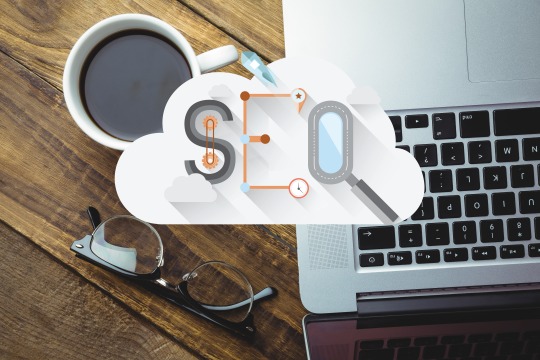
SEO Freelancer in India - Digital Pool
Hire an SEO freelancer from Digital Pool and get your website ranked higher on Google search results. Our freelancers are experts in all aspects of SEO, including keyword research, on-page optimization, link building, and technical SEO.
#Best SEO Freelancer in India#seo freelancer#freelancers seo#seo marketing#seo services#seo company#seo case study#seo agency#seo#SEO Freelancer in India#Top SEO Freelancer in India#Hire SEO Freelancer in India#Digital Pool SEO Freelancer#SEO Freelancer for Small Businesses in India#SEO Freelancer for Startups in India#SEO Freelancer for E-Commerce Websites in India#SEO Freelancer for Lead Generation in India
0 notes
Text
Top Shopify Store Seo Techniques
For expert advice, consider a Shopify app agency. They’re specialists in making your store work great, ensuring you get the most from your chosen app.
Read Blog : - https://www.juststunninglife.com/top-shopify-store-seo-techniques/
#makkpress technologies#bigcommerce seo#ecommerce seo services#case study#bigcommerce migration#opencart seo#ecommerce migration
0 notes
Text
Unbounce for SaaS Companies: Onboarding Pages
II. Key Elements of Onboarding Pages
A. User-friendly design and navigation
Creating an intuitive and visually appealing design is paramount for onboarding pages. Users should be able to navigate effortlessly, guiding them through the initial steps of using the SaaS product. Incorporate a clean layout, logical flow, and easily understandable icons to enhance the overall user experience.
B. Clear value proposition and benefits
The onboarding page serves as the first introduction to your SaaS product, making it crucial to convey a clear value proposition. Clearly articulate the benefits users will gain from your product, addressing pain points and highlighting unique selling points. Use concise and compelling language to capture their attention and emphasize the value they'll receive.
C. Interactive and engaging content
Make the onboarding process interactive and engaging to keep users invested. Incorporate interactive elements such as guided tours, tooltips, or on-screen tutorials that provide a hands-on experience. This not only helps users understand the functionality of your SaaS product but also creates a memorable onboarding experience, increasing the likelihood of user retention.
D. Seamless integration with SaaS product features
Ensure that the onboarding pages seamlessly integrate with your SaaS product features. Allow users to explore the core functionalities directly from the onboarding stage. This integration helps users grasp the practical aspects of your product, promoting a smooth transition from the onboarding phase to active usage. Highlight key features and demonstrate their usage to empower users right from the start.
In conclusion, crafting effective onboarding pages for SaaS companies involves a strategic blend of design, communication, interactivity, and integration. By prioritizing user-friendly elements and emphasizing the value proposition, SaaS companies can significantly enhance the onboarding experience, setting the stage for long-term user satisfaction and loyalty.
Creating Onboarding Pages with Unbounce
I. Introduction
In the realm of Software as a Service (SaaS), first impressions matter, and effective onboarding is the key to user retention and satisfaction. Unbounce, known for its versatile landing page capabilities, proves to be a valuable tool for SaaS companies aiming to enhance their onboarding process.
II. Unbounce Basics
A. Key Features Relevant to SaaS Onboarding
Understanding the unique needs of SaaS companies, Unbounce offers features tailored to streamline the onboarding experience. From customizable templates to interactive elements, Unbounce provides a toolkit to craft onboarding pages that resonate with users.
B. Creating a Landing Page for Onboarding
A step-by-step guide walks through the process of leveraging Unbounce for designing compelling onboarding pages. This includes selecting appropriate templates, integrating interactive elements, and optimizing the flow for a seamless user experience.
III. Onboarding Pages with Unbounce
A. Overview of Unbounce Features for SaaS Onboarding
Unbounce boasts features specifically designed to facilitate SaaS onboarding. These include drag-and-drop functionality, responsive design options, and integrations with popular SaaS platforms. Understanding these features is crucial for maximizing the impact of onboarding pages.
B. Step-by-Step Guide on Designing Onboarding Pages
Delve into the practical aspects of using Unbounce for crafting onboarding pages. The guide covers essential elements such as user flow, interactive walkthroughs, and incorporating user feedback loops. Each step is illustrated to empower SaaS companies to create engaging onboarding experiences.
IV. Benefits of Using Unbounce for SaaS Onboarding
Unbounce offers several advantages for SaaS companies seeking to optimize their onboarding process.
A. Seamless Integration with SaaS Platforms
Unbounce seamlessly integrates with popular SaaS platforms, allowing for a cohesive onboarding experience. This integration ensures that user data is synchronized, providing a personalized journey from the landing page to the SaaS application.
B. Data-Driven Optimization
Utilizing Unbounce's analytics, SaaS companies can gather valuable insights into user behavior during the onboarding process. This data-driven approach enables continuous optimization, ensuring that onboarding pages evolve based on user interactions and feedback.
In conclusion, Unbounce emerges as a valuable ally for SaaS companies looking to elevate their onboarding process. By harnessing the platform's features and following a strategic design approach, SaaS businesses can create onboarding pages that captivate users and set the stage for long-term engagement.
In the fast-paced world of SaaS companies, creating a seamless onboarding experience is paramount for user retention and satisfaction. In this post, we delve into the customization and branding aspects of Unbounce for SaaS companies' onboarding pages.
IV. Customization and Branding
A. Importance of aligning onboarding pages with SaaS company branding:
One of the key elements of a successful onboarding process is ensuring that it seamlessly aligns with the branding of the SaaS company. Unbounce provides a versatile platform where design elements can be tailored to reflect the unique identity of the brand. From color schemes to typography, maintaining brand consistency fosters a sense of familiarity and trust with users.
Customization goes beyond aesthetics; it's about creating an onboarding journey that resonates with the target audience. By incorporating the company's logo, tagline, and visual elements, Unbounce allows SaaS companies to reinforce their brand identity at every step of the onboarding process. This not only enhances the user experience but also contributes to long-term brand recognition.
B. Using Unbounce to customize and maintain brand consistency:
Unbounce simplifies the customization process, empowering SaaS companies to create onboarding pages that not only look visually appealing but also align with their unique brand guidelines. The platform offers an intuitive drag-and-drop interface, making it easy to add or modify elements on the page without the need for extensive coding skills.
Beyond visual elements, Unbounce allows for the incorporation of interactive elements that can elevate the onboarding experience. From engaging animations to personalized greetings, these customization options contribute to a dynamic onboarding process that captures the user's attention and keeps them actively involved.
Maintaining brand consistency is an ongoing process, and Unbounce streamlines it by providing features like templates and style guides. SaaS companies can create standardized templates that adhere to their branding guidelines, ensuring a cohesive look across all onboarding pages. This not only saves time but also guarantees a unified brand presence, reinforcing the company's image in the minds of users.
In conclusion, Unbounce serves as a powerful ally for SaaS companies looking to optimize their onboarding pages. By prioritizing customization and brand consistency, businesses can create a memorable onboarding experience that sets the stage for long-term user engagement and loyalty.
In the realm of SaaS companies, crafting effective onboarding experiences is paramount for user retention and satisfaction. Unbounce, a versatile landing page builder, proves to be a valuable asset in this regard. In this post, we delve into advanced strategies for A/B testing onboarding pages using Unbounce, highlighting its significance and providing actionable insights for optimization.
A. The Significance of A/B Testing in Optimizing Onboarding Experiences
A/B testing, also known as split testing, is a methodical approach to assess variations in webpage elements, aiming to determine which version performs better in terms of user engagement and conversions. When applied to onboarding pages, this methodology becomes a powerful tool for SaaS companies to fine-tune the user journey from the outset.
Onboarding pages play a pivotal role in guiding users through the initial interactions with a SaaS product. Each element, from the headline and visuals to the call-to-action buttons, contributes to shaping the user's perception and experience. A/B testing allows for systematic experimentation with different variations of these elements, helping to identify the most effective combination that enhances user comprehension and engagement.
B. Implementing A/B Testing with Unbounce for SaaS Onboarding Pages
Unbounce facilitates seamless A/B testing, offering a user-friendly interface that empowers SaaS companies to experiment with various elements of their onboarding pages. The platform allows users to create multiple versions of a landing page, each with distinct variations in design, content, or functionality.
To initiate A/B testing with Unbounce for SaaS onboarding pages, follow these steps:
Page Element Variations: Identify specific elements on your onboarding page that you want to test. This could include headlines, form fields, images, or the overall layout.
Create Variations: Use Unbounce's intuitive editor to create different versions of your onboarding page, incorporating the identified variations. Ensure that each version is distinct enough to produce meaningful insights.
Set Testing Parameters: Define the metrics you want to measure, such as conversion rates, click-through rates, or bounce rates. Unbounce allows you to set testing parameters and automatically directs traffic to the different variations.
Monitor and Analyze: As the A/B test runs, monitor the performance of each variation through Unbounce's analytics tools. Pay attention to user interactions, conversion rates, and other relevant metrics.
Implement Changes: Based on the results, implement changes to your onboarding page. Whether it's refining the messaging, adjusting the layout, or optimizing the call-to-action, use the insights gained to enhance the overall onboarding experience.
In conclusion, A/B testing with Unbounce empowers SaaS companies to iteratively enhance their onboarding pages, fostering a seamless and engaging user journey. By leveraging this approach, businesses can fine-tune their onboarding process, ensuring that users embark on their SaaS experience with clarity and enthusiasm.
Title: Unbounce for SaaS Companies: Mastering Onboarding Pages
Introduction:
In the competitive landscape of Software as a Service (SaaS) companies, effective onboarding is paramount for user retention and satisfaction. Unbounce, a versatile landing page builder, offers unique features tailored for optimizing onboarding pages. In this post, we delve into the analytics and data-driven strategies to ensure your SaaS onboarding experience excels.
VI. Analytics and Data-driven Improvements
A. Leveraging Unbounce Analytics:
Unbounce provides robust analytics tools that offer deep insights into user behavior on your onboarding pages. Track user interactions, bounce rates, and conversion metrics to understand how visitors engage with your content. Utilize heatmaps and session recordings to visualize the user journey and identify potential friction points in the onboarding process.
B. Making Data-driven Decisions:
Analyzing the data collected through Unbounce can guide strategic decision-making. Identify drop-off points in the onboarding flow and implement A/B testing to experiment with different elements such as form fields, CTAs, and instructional content. By systematically testing variations, you can refine your onboarding process based on real user interactions, leading to continuous improvement.
Case Study:
Consider a scenario where Unbounce analytics reveal a significant drop-off after a particular step in the onboarding process. Through A/B testing, you discover that simplifying the information presented at that stage increases user engagement. This data-driven adjustment results in a noticeable boost in conversion rates, emphasizing the impact of strategic decision-making based on Unbounce analytics.
Conclusion:
Effectively utilizing Unbounce for onboarding pages empowers SaaS companies to refine their user experiences and drive conversions. By leveraging Unbounce analytics and making data-driven decisions, businesses can adapt and optimize onboarding processes, ensuring a seamless journey for users. Stay tuned for our next installment, where we explore advanced strategies for enhancing the SEO performance of your Unbounce-powered SaaS onboarding pages.
Unbounce for SaaS Companies: Onboarding Pages
In the fast-paced realm of Software as a Service (SaaS), creating seamless onboarding experiences is crucial for user retention and satisfaction. In this post, we will delve into optimizing onboarding pages using Unbounce, a versatile landing page builder tailored for SaaS companies.
VII. Mobile Responsiveness and Accessibility
A. Ensuring Onboarding Pages are Mobile-Friendly
Mobile usage is ubiquitous, making it imperative for onboarding pages to be seamlessly accessible on various devices. Unbounce provides a user-friendly interface to create responsive designs. Utilize the platform's mobile preview features to ensure your onboarding pages look and function seamlessly on smartphones and tablets. Optimize images and minimize heavy elements to enhance loading speed, crucial for retaining mobile users.
B. Using Unbounce Features for Optimizing Accessibility
Accessibility is a fundamental aspect often overlooked. Unbounce offers features to enhance the accessibility of your onboarding pages. Incorporate alt text for images, ensuring compatibility with screen readers. Customize font styles and sizes for better readability, catering to users with different needs. Unbounce's drag-and-drop functionality simplifies the process, allowing even those without extensive coding knowledge to create accessible onboarding experiences.
Ensuring your onboarding pages are mobile-friendly and accessible contributes to a positive user experience, broadening your SaaS company's reach.
In the competitive landscape of Software as a Service (SaaS) companies, effective onboarding is crucial for user retention and satisfaction. In this post, we delve into optimizing onboarding pages using Unbounce, a powerful tool for creating landing pages without the need for coding. Here are some insights into SEO best practices tailored for onboarding pages:
A. Understanding the Role of SEO in Attracting Relevant Traffic
Search Engine Optimization (SEO) plays a pivotal role in driving organic traffic to your onboarding pages. Users often rely on search engines to find solutions, and by implementing SEO best practices, you can ensure that your SaaS onboarding pages rank high in relevant search results.
To start, conduct thorough keyword research to identify terms and phrases potential users might use when seeking a SaaS solution similar to yours. Utilize tools like Google Keyword Planner or SEMrush to discover high-impact keywords in your niche.
Additionally, focus on creating high-quality, informative content. Craft compelling meta titles and descriptions that not only include target keywords but also entice users to click through. Google's algorithm rewards pages that provide value, so ensure your onboarding content is relevant, engaging, and aligns with user intent.
B. Implementing SEO Strategies Specific to Unbounce Onboarding Pages
When using Unbounce for SaaS onboarding pages, there are specific strategies you can employ to enhance SEO performance:
Optimize Page Speed: Google considers page speed a critical factor in search rankings. Unbounce provides optimization features, such as image compression and script management, to help improve your onboarding page loading times.
Mobile Responsiveness: Given the prevalence of mobile users, ensure that your onboarding pages are fully responsive. Unbounce's mobile-friendly designs enable you to create a seamless experience across various devices, positively impacting SEO.
Structured Data Markup: Implement structured data markup on your Unbounce onboarding pages to provide search engines with additional context about your content. This can enhance the visibility of rich snippets in search results.
Backlink Strategies: Foster backlinks from reputable sources to establish your onboarding pages' authority. Share valuable insights through blog posts, webinars, or whitepapers, and use Unbounce's analytics to track the success of your link-building efforts.
By integrating these SEO best practices into your Unbounce onboarding pages, you can significantly improve your SaaS company's online visibility, attract the right audience, and drive successful onboarding experiences for your users.
One of the lesser-known aspects of Unbounce lies in its potential for revolutionizing the way SaaS companies approach onboarding pages. In this post, we delve into the specifics to help you make the most out of this dynamic tool.
IX. Integration with SaaS Platforms
A. Seamless Integration with Popular SaaS Platforms
Unbounce isn't just a standalone landing page builder—it seamlessly integrates with popular SaaS platforms, creating a harmonious ecosystem for your onboarding process. Whether you're using customer relationship management (CRM) tools, project management software, or communication platforms, Unbounce ensures a smooth connection. This integration facilitates a streamlined onboarding experience, allowing your users to transition effortlessly from their first interaction with your landing page to the heart of your SaaS product.
B. Enhancing User Experience through Unbounce-SaaS Platform Synergy
The synergy between Unbounce and SaaS platforms goes beyond mere integration—it's about enhancing user experience. Leverage the power of Unbounce to create onboarding pages that are not just informative but also interactive. Embed videos, walkthroughs, and interactive elements directly on your landing pages, providing users with a hands-on introduction to your SaaS offering. This not only reduces the learning curve but also increases user engagement and satisfaction.
Imagine a scenario where a potential user clicks on your ad, lands on a Unbounce-crafted onboarding page, and experiences a seamless transition into your SaaS platform. The integration ensures that user data is seamlessly transferred, offering a personalized onboarding journey. This not only saves time but also creates a cohesive brand experience, instilling confidence in your users from the get-go.
As SaaS companies continue to evolve, embracing the power of Unbounce for onboarding pages becomes not just a choice but a strategic necessity. The ability to integrate with a variety of SaaS platforms and enhance user experience positions Unbounce as a valuable asset in the arsenal of tools for any SaaS marketer.
Unlock the full potential of your SaaS onboarding strategy by harnessing the integration capabilities and user-centric features that Unbounce brings to the table. Your onboarding pages are not just gateways; they are the first steps in a journey, and with Unbounce, you can ensure that this journey begins on the right foot.
FAQs: Unbounce for SaaS Companies - Onboarding Pages
Q1: What makes Unbounce suitable for SaaS onboarding pages?
A1: Unbounce provides a user-friendly platform to create custom onboarding pages tailored to SaaS companies. Its drag-and-drop interface and customizable templates make designing intuitive and efficient.
Q2: Can Unbounce integrate with different SaaS platforms?
A2: Yes, Unbounce offers seamless integration with various SaaS platforms, ensuring a smooth onboarding process. This integration enhances user interaction and data synchronization.
Q3: How does Unbounce contribute to a better onboarding experience?
A3: Unbounce enables SaaS companies to create personalized onboarding experiences. Its features, such as dynamic text replacement and A/B testing, allow for continuous improvement based on user engagement.
Q4: Are there specific templates for SaaS onboarding pages?
A4: Unbounce provides templates specifically designed for SaaS onboarding. These templates are optimized for showcasing product features, benefits, and guiding users through the onboarding journey.
Q5: Can Unbounce be used for multi-step onboarding processes?
A5: Absolutely. Unbounce allows the creation of multi-step forms and pages, facilitating a phased onboarding approach. This is particularly beneficial for SaaS companies with intricate onboarding processes.
Q6: How can Unbounce help in user data collection during onboarding?
A6: Unbounce's form builder makes it easy to collect user data during the onboarding process. The platform supports various form fields, making it adaptable to the specific information SaaS companies need from their users.
Q7: Is Unbounce suitable for onboarding pages aimed at mobile users?
A7: Yes, Unbounce ensures mobile responsiveness, crucial for SaaS companies targeting users on different devices. Mobile-optimized onboarding pages contribute to a seamless user experience.
Q8: Can Unbounce assist in A/B testing for SaaS onboarding pages?
A8: Unbounce offers robust A/B testing features, allowing SaaS companies to experiment with different onboarding strategies. This helps in identifying the most effective elements for user engagement and conversion.
Q9: How does Unbounce handle user privacy and data security for SaaS onboarding?
A9: Unbounce prioritizes data security and privacy. The platform adheres to industry standards, ensuring that user data collected during the onboarding process is handled with the utmost care and compliance.
Q10: Are there resources or support for optimizing SaaS onboarding pages on Unbounce?
A10: Unbounce provides comprehensive support resources, including tutorials and community forums, to help SaaS companies optimize their onboarding pages. The Unbounce support team is also available for personalized assistance.
Certainly! Here's a glossary with thirty less-known terms related to Unbounce for SaaS Companies and Onboarding Pages:
Churn Rate: The percentage of subscribers or customers who leave a SaaS platform during a given time period.
Microinteractions: Small, subtle design elements on onboarding pages that enhance user experience.
Gamification: Introducing game-like elements to encourage user engagement during the onboarding process.
Usability Testing: Evaluating the ease of use and user-friendliness of onboarding pages through real user interactions.
Heatmap: Visual representation of user interactions on a webpage, indicating where users focus their attention.
Feature Flags: A technique in software development allowing the enablement or disablement of features remotely without deploying code changes.
Customer Segmentation: Dividing users into groups based on characteristics for personalized onboarding experiences.
CX (Customer Experience): The overall experience a customer has with a SaaS company, including onboarding.
Drip Campaigns: Sending a series of automated messages to users over time, often used during onboarding to nurture leads.
Product-Led Growth: A business strategy that relies on the product itself to drive acquisition, conversion, and expansion.
Zero UI: Interfaces that require little to no direct interaction from the user, often seen in automated onboarding processes.
API (Application Programming Interface): A set of rules allowing different software applications to communicate with each other.
Feature Bloat: The negative impact on user experience caused by an excess of features in a SaaS product.
Single Sign-On (SSO): A session/user authentication process that enables a user to access multiple applications with one set of login credentials.
Onboarding Flow: The sequence of steps a user follows during the initial setup and exploration of a SaaS platform.
Customer Health Score: A metric indicating the overall satisfaction and engagement of a SaaS customer.
In-App Messaging: Communication with users within the application, often used for onboarding guidance.
Multivariate Testing: Testing multiple variations of onboarding elements simultaneously to determine the most effective combination.
User Persona: A fictional representation of a user based on data, helping in designing personalized onboarding experiences.
Intercom: A customer messaging platform that facilitates communication and engagement during the onboarding process.
Journey Mapping: Visualizing the entire user journey, from discovery to onboarding and beyond, to identify pain points.
Semantic UI: A development framework that uses human-friendly HTML to create responsive and customizable user interfaces.
Webhooks: Automated messages sent from one application to another, triggered by specific events.
Retention Rate: The percentage of customers that a SaaS company retains over a specific period.
User Flow: The path a user takes through a SaaS application, often analyzed to optimize onboarding.
Tokenization: The process of replacing sensitive data with unique identification symbols, enhancing security in onboarding.
Progressive Disclosure: Gradually revealing information to users, preventing information overload during onboarding.
Time-To-Value (TTV): The duration it takes for a user to derive value from a SaaS product.
MVP (Minimum Viable Product): The most basic version of a product with just enough features to satisfy early customers.
Conversion Funnel: The series of steps a user goes through, from landing on the onboarding page to becoming an active user of the SaaS platform.

#Unbounce#SaaS Onboarding#Landing Pages#User Experience#A/B Testing#Analytics#SEO#Mobile Optimization#Branding#Integration#Case Studies#Future Trends
0 notes
Text
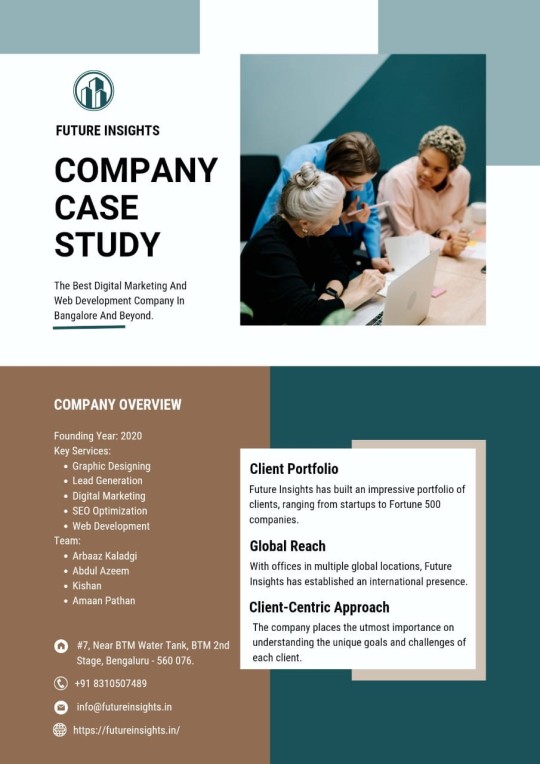
Case Study: Future Insights
The Best Digital Marketing and Web Development Company
Introduction:
Future Insights is a leading digital marketing and web development company that has gained prominence in the ever-evolving landscape of the tech industry.
Established in 2020, the company has steadily grown and established itself as a key player in the digital realm. This case study delves into Future Insights’ journey, its services, notable achievements, and the strategies that have contributed to its success.
Company Overview:
Name: Future Insights
Founding Year: 2020
Location: #7, Near BTM Water Tank, BTM 2nd Stage, Bengaluru — 560 076.
Key Services: Digital Marketing, Web Development, SEO, Social Media Management, Content Creation, E-commerce Solutions.
Founder: Arbaaz Kaladgi
1. Evolution of Future Insights:
Future Insights was born out of a vision to provide innovative and comprehensive digital solutions to businesses across industries. Initially, it started as a small web development agency, focusing on creating visually appealing and functional websites. Over the years, the company evolved to encompass a broader range of services, including digital marketing and SEO.
2. Service Offerings:
a. Web Development: Future Insights specializes in creating custom websites and web applications that are not only aesthetically pleasing but also user-friendly and optimized for performance. They leverage the latest web technologies to deliver exceptional user experiences.
b. Digital Marketing: The company offers a full suite of digital marketing services, including search engine optimization (SEO), pay-per-click advertising (PPC), social media marketing, email marketing, and content marketing. Their data-driven approach ensures that clients achieve their online marketing goals effectively.
c. E-commerce Solutions: Future Insights has a dedicated team that specializes in developing e-commerce platforms for businesses looking to expand their online presence. They have successfully launched and maintained numerous e-commerce websites for clients in various industries.
3. Notable Achievements:
a. Client Portfolio: Future Insights has built an impressive portfolio of clients, ranging from startups to Fortune 500 companies. Their ability to tailor solutions to meet the unique needs of each client has contributed to their reputation for excellence.
b. Industry Recognition: The company has received several industry awards and accolades for its outstanding work in digital marketing and web development. These recognitions underline their commitment to innovation and quality.
c. Global Reach: With offices in multiple global locations, Future Insights has established a strong international presence. This global perspective has enabled them to offer culturally sensitive and region-specific marketing strategies.
4. Core Strategies:
a. Innovation: Future Insights consistently invests in research and development to stay at the forefront of technological advancements. This commitment to innovation enables them to deliver cutting-edge solutions to their clients.
b. Client-Centric Approach: The company places the utmost importance on understanding the unique goals and challenges of each client. They tailor their services to align with the client’s business objectives, ensuring maximum impact.
c. Data-Driven Decisions: Future Insights relies heavily on data analytics to guide their digital marketing efforts. This data-centric approach enables them to make informed decisions and continually refine their strategies for better results.
Conclusion:
Future Insights has emerged as a trailblazer in the digital marketing and web development industry through its commitment to excellence, innovation, and client-centricity. With a diverse portfolio, global presence, and a focus on data-driven strategies, the company is well-positioned to continue its growth and make a lasting impact on the digital landscape. Future Insights serves as an inspiring example of how a vision and dedication to quality can lead to remarkable success in the digital realm.
0 notes
Photo

Expedia is a leading online travel agency that helps travelers plan and book their trips. Founded in 1996, Expedia has since expanded its services to include flights, hotels, rental cars, cruises and vacation packages. The company provides users with access to an extensive network of travel suppliers worldwide.
With over 20 years of experience in the industry, Expedia has established itself as a trusted source for all things travel-related. Its user-friendly website and mobile app make it easy for customers to browse through various options and filter results according to their preferences.
Read Full Article on Expedia SEO Case Study
0 notes